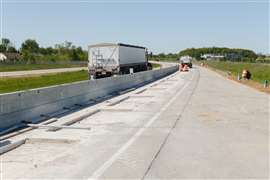Read this article in Français Deutsch Italiano Português Español
How civil engineers are developing an innovative EV-charging highway prototype
28 May 2024
What if roads could wirelessly charge our electric vehicles as we drove over them?
 Construction works from 1 May on a quarter-mile segment of highway that will be used for testing the wireless power transfer to a heavy-duty electric truck. (Image: Purdue University/Greta Bell)
Construction works from 1 May on a quarter-mile segment of highway that will be used for testing the wireless power transfer to a heavy-duty electric truck. (Image: Purdue University/Greta Bell)
That’s exactly the question a team of civil engineers and scientists at Purdue University in Indiana, US, are answering as part of the US National Science Foundation’s Advancing Sustainability through Power Infrastructure for Road Electrification Initiative (ASPIRE), which is part of the group’s Engineering Research Center programme.
The idea is simple: build an in-highway electric charging system that wirelessly maintains an EV battery’s charge for vehicles up to the size of a semi tractor-trailer.
Called the Dynamic Wireless Power Transfer (DWPT) project, it’s a product that already exists in a stationary form for end users.
John Haddock, civil engineering professor at Purdue who is helming the school’s role in the project, says, “You can buy the technology for stationary charging; you could put one in your garage so when you pull your cover over it, it would charge your car and you wouldn’t have to plug anything in.”
Haddock said his team is taking that concept and making it dynamic by building it into roads so that vehicles as large as semis – driving at 65 miles-per-hour (105 km/hr) – could maintain a charge.
“Meaning that the cars would actually, as they’re driving down the road, be able to take a charge from the system,” he explains, noting it uses a magnetic field to transfer electrical energy. “The system is an inductive system.”
Haddock clarifies that the tech likely wouldn’t be strong enough to add to the vehicle’s charge but would prevent a discharge while using the electric road.
 Purdue University professor John Haddock, left, and graduate student Oscar Moncada examine a slab of concrete pavement with wireless power-transfer technology. The machine in the back was designed to mimic half a semi-truck axle to test the prototype’s functionality. (Image: Provided by Consensus Digital Media)
Purdue University professor John Haddock, left, and graduate student Oscar Moncada examine a slab of concrete pavement with wireless power-transfer technology. The machine in the back was designed to mimic half a semi-truck axle to test the prototype’s functionality. (Image: Provided by Consensus Digital Media)
“The system [could] charge the battery in smaller vehicles,” Haddock speculates, saying a truck like the Ford F-150 Lightning could actually increase its range while driving charging highways.
Purdue, along with US engine and power generation manufacturer Cummins, the Indiana Department of Transportation (InDOT), American infrastructure consulting firm AECOM, engineers PC Krause and Associates, and contractor White Construction collaborated on the project, construction for which started on April 1. Once the prototype build is complete, test runs will be conducted through autumn of 2024.
Using the same science that smart phones use to wirelessly charge when placed on a landing pad, the prototype is located on a small stretch of road on US motorways 231 and 52 in West Lafayette, Indiana, US.
The charging technology was designed so it could be retrofitted into existing road networks.
Eventually, InDOT plans to build a quarter-mile-long (0.4km-long) testbed to specifically test the concrete’s capacity to charge heavy trucks at 200 kW and more, according to Purdue. The assessment will not be for public users, however, as the charging will only be activated during testing periods.
Economic viability ‘speculative’
While it’s too early to suggest EV-charging roads will be a staple of America’s future, the DWPT project has significant upside if any entity or municipality can figure out the economics.
“This technology will work,” says John Kresse, Cummins’ director of hybrid and electrification technologies, “but the economic viability is highly speculative.”
Cummins is providing the battery-electric truck which will be used in testing the DWPT. The vehicle will be integrated with Purdue’s charging system to better monitor the charging capabilities.
 For a pilot project expected to start in 2025, the black coils in the foreground of this photo will be used to transfer power to the heavy-duty electric Cummins truck in the background. (Image: Purdue University/Greta Bell)
For a pilot project expected to start in 2025, the black coils in the foreground of this photo will be used to transfer power to the heavy-duty electric Cummins truck in the background. (Image: Purdue University/Greta Bell)
Purdue’s Haddock suggested a similar model to expressways or tollways could figure out the dollars-and-cents: drivers pay to access the charging capability and are charged per use.
In the early stages, though, there are (understandably) more questions than answers.
“Can it be deployed in a cost-effective manner, and will it be utilised to recover those costs? Can the ‘cost of power transfer’ for the fleet operators be made relatively comparable to wire charging?” asks Kresse rhetorically.
If value can be achieved, “it can provide tremendous benefit in enabling a battery electric truck to achieve high range, [eliminate or reduce] dwell times associated with charging, and [reduce] battery size,” he answers.
The DWPT concept, Haddock said, would be best employed on high-traffic motorways; particularly ones with considerable freight and cross-country traffic.
“Not all roads would need it,” says Haddock. “The only way it can be cost effective is if it’s designed for heavy trucks, [and] not all pavements would need it; not the entire length.”
Haddock adds, looking ahead, a state DOT would be wise to stagger the technology.
“Maybe you have it for ten miles (16km) and then you don’t have any for 20 miles (32km),” offered Haddock.
Kresse points to research suggesting only 20% of US interstate highways would need to have the tech to have an impact.
“The industry will not require 100% of the highways to have dynamic wireless power transfer,” he confirms, noting that, still, it’s a high-cost endeavour at 20%.
Whatever the price may be a decade or more from now doesn’t lessen the potential, however, and Indiana’s DOT is eagerly waiting a future of self-charging wireless roads.
“If successful, the window of opportunity is wide open for further innovation, which would be discussed upon the test pilot’s completion,” says InDOT.
STAY CONNECTED


Receive the information you need when you need it through our world-leading magazines, newsletters and daily briefings.
CONNECT WITH THE TEAM












